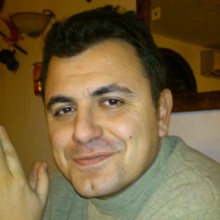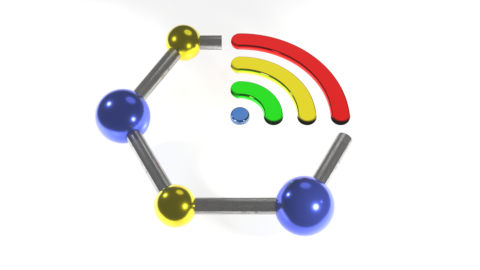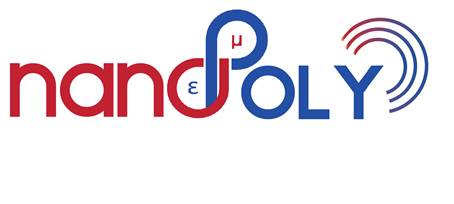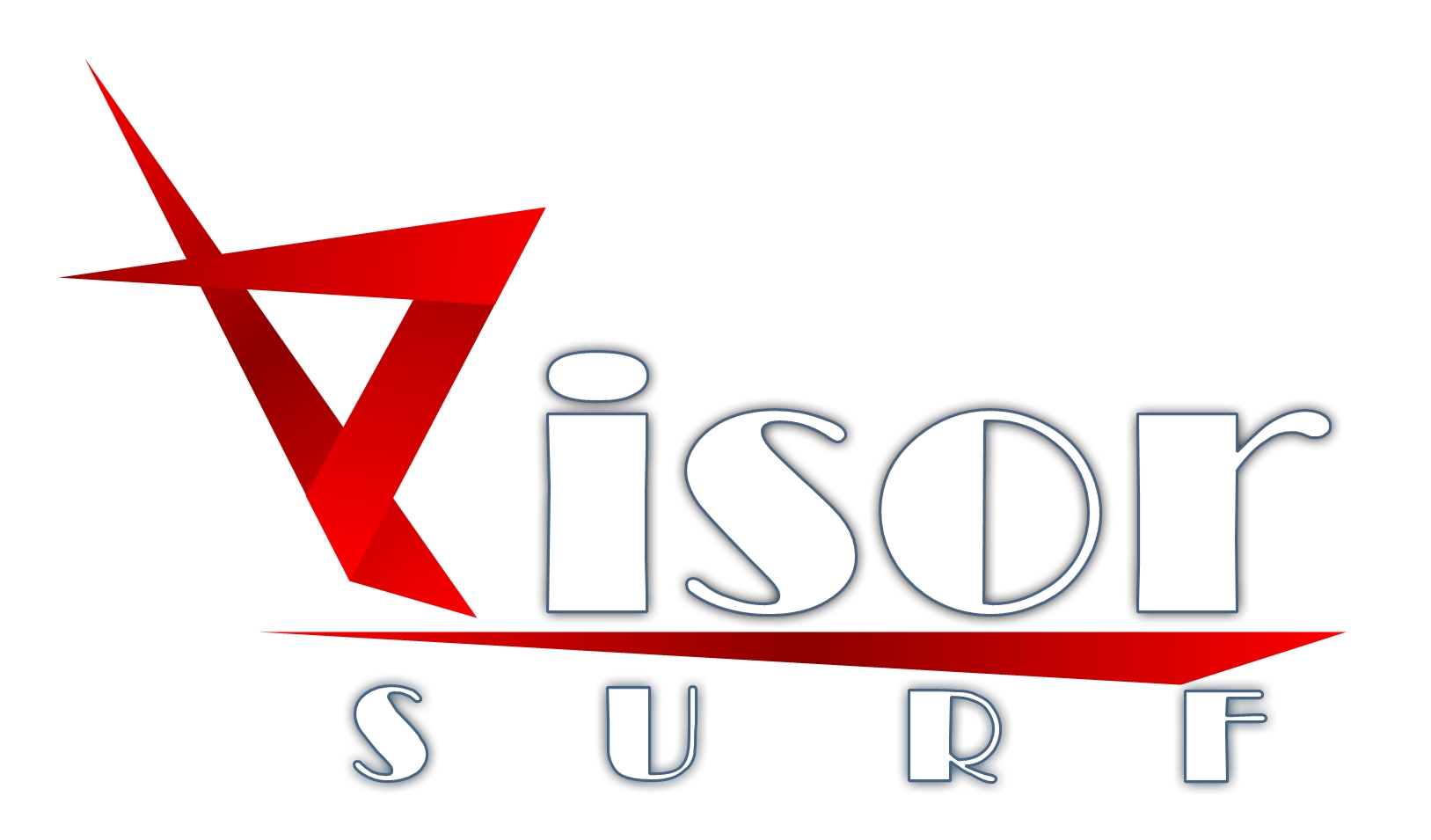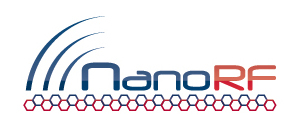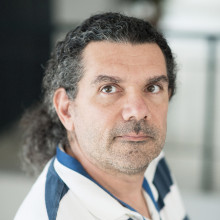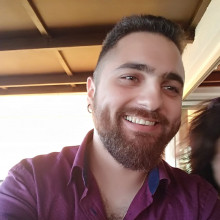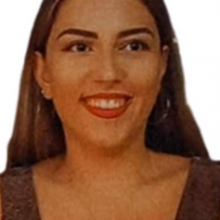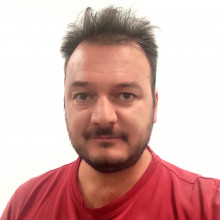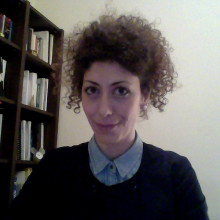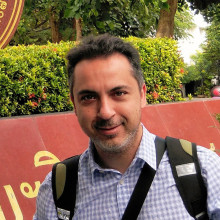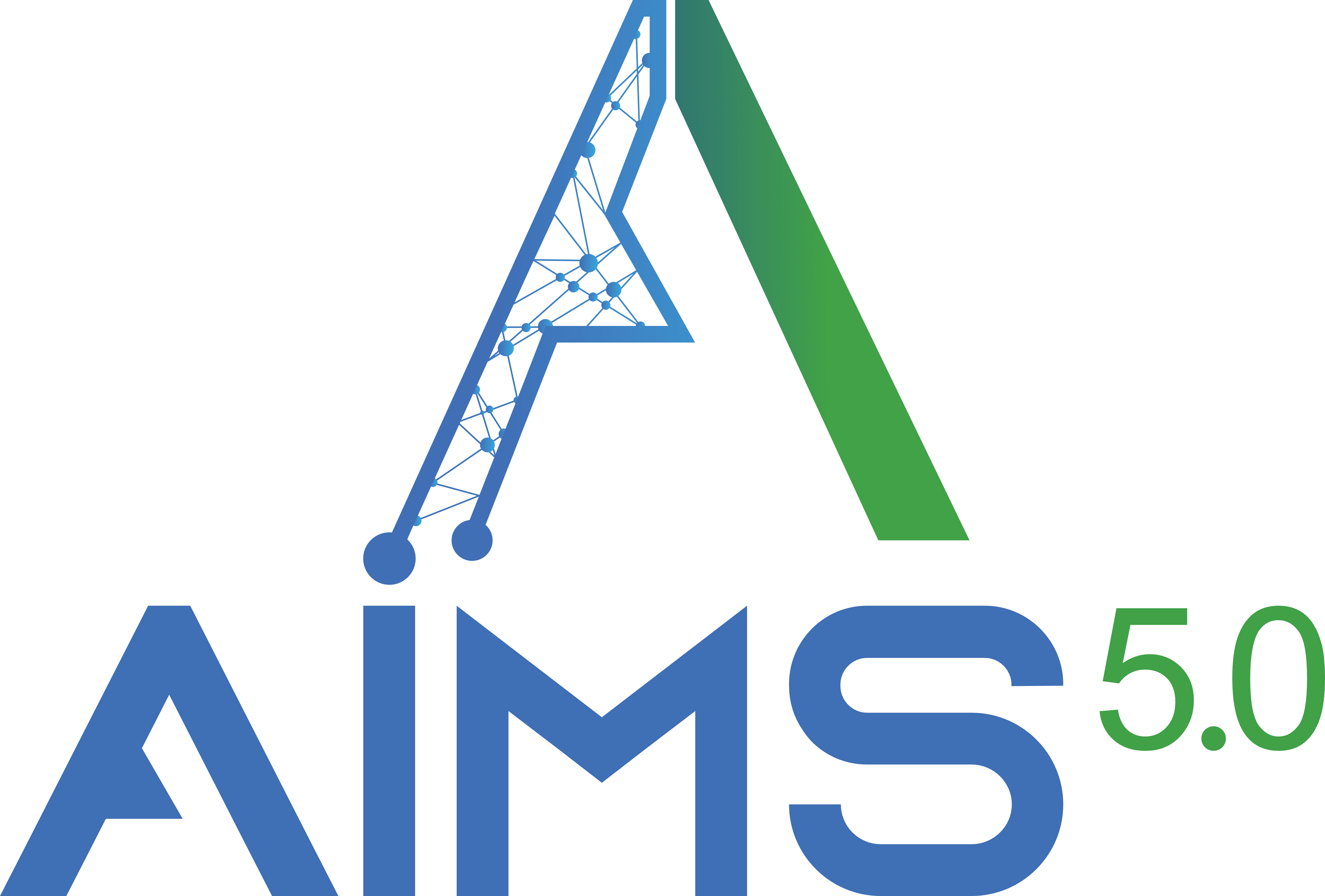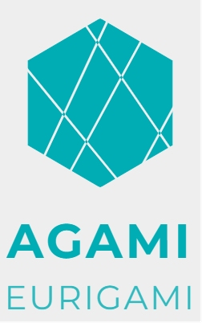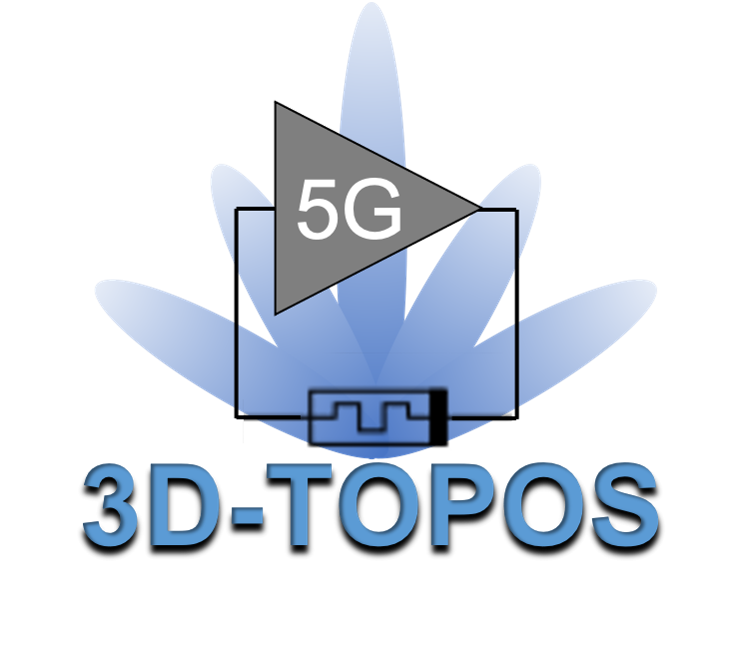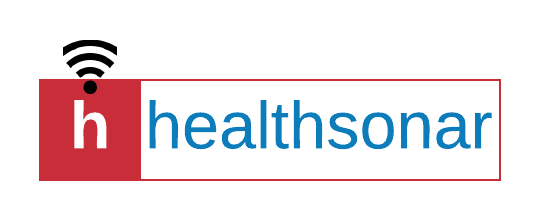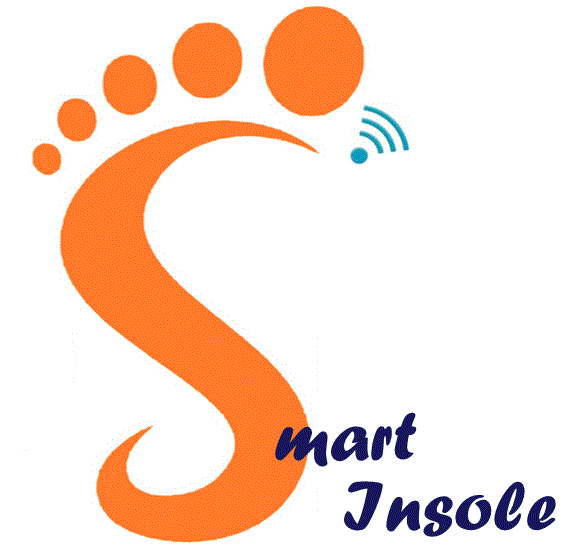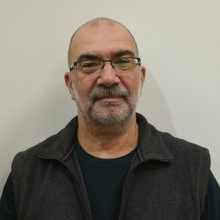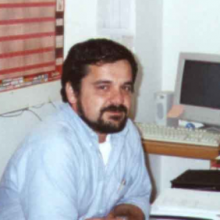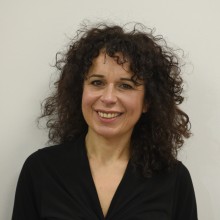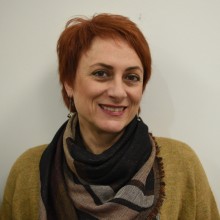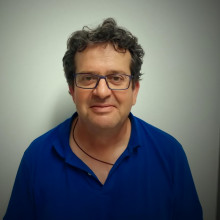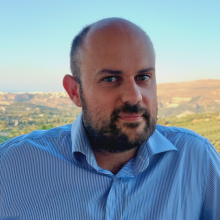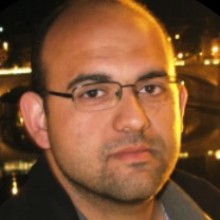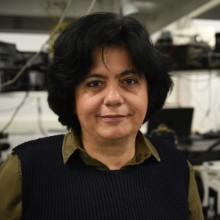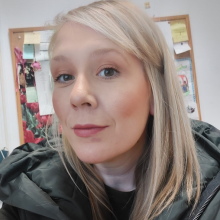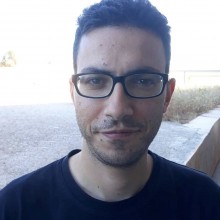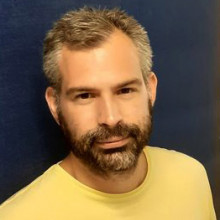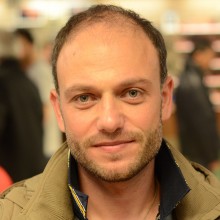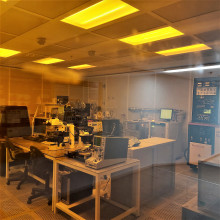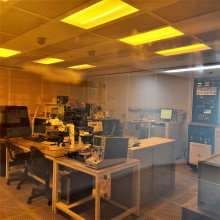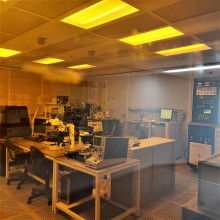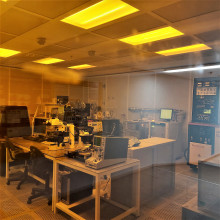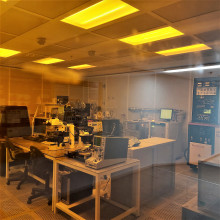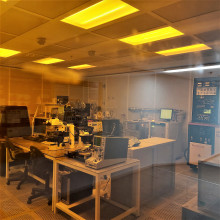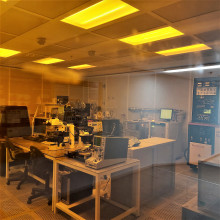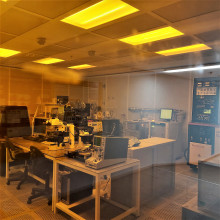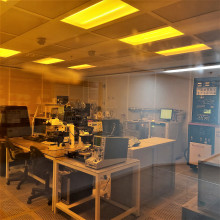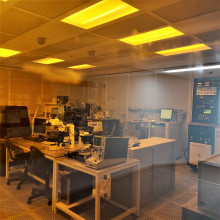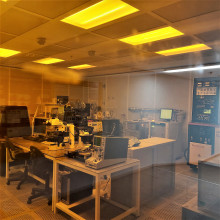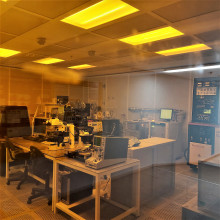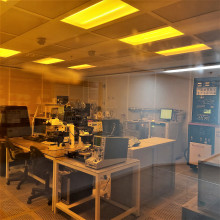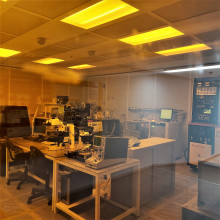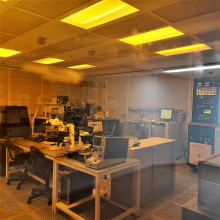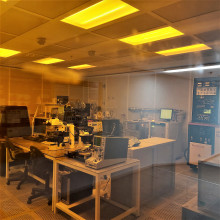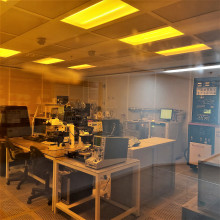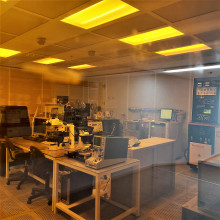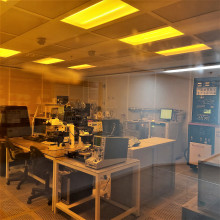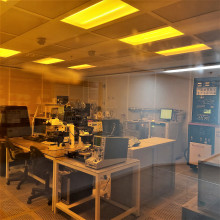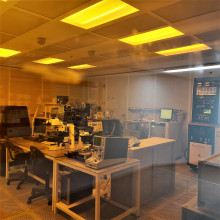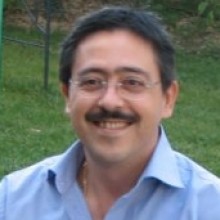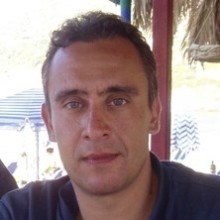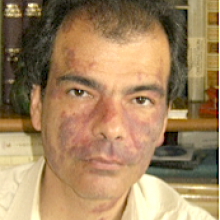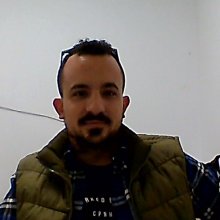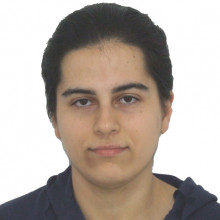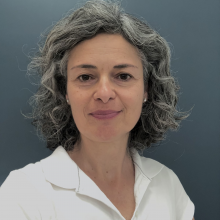
Education
- 2002 PhD in Engineering, Warwick Manufacturing Group, University of Warwick, UK
- 1998 MSc in Manufacturing Systems Engineering, Warwick Manufacturing Group, University of Warwick, UK
- 1997 MechEng in Mechanical Engineering Aristotle University of Thessaloniki
Career
- 2014(-present) Technician at Attosecond Sceince and Technology Laboratory
- RnD Engineer Mechatron 2011–2014
- Lecturer
Interests
- Computational modelling, numerical and quantitative methods
- Composite material model based on Continuum Damage Mechanics
- Statistic inference of univariate and multivariate dataset
- Visualisation and interpretation of multivariate dataset
- Finite Element analysis
- Structural Mechanics and Strength of Materials
- Non Destructive Testing (NDT) methods (i.e. Acoustic Emissions, Thermal Imaging)
- Digital Signal Processing (DSP)
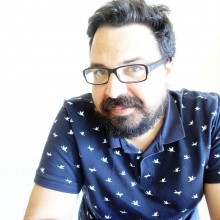
Emmanouil Skantzakis is a physicist specializing in both experimental and theoretical aspects of attosecond physics. He graduated in Physical Engineering from the National Technical University of Athens in 2004 and initiated his career at the Institute of Electronic Structure and Laser of the Foundation for Research and Technology Hellas (I.E.S.L.-FO.R.T.H.).
During his academic pursuit, Skantzakis followed a master's program at the University of Crete, concentrating on "Microelectronics-Optoelectronics." Under the guidance of Prof. Dimitris Charalambidis, his master's thesis was focused on the modelling and implementation of a grating interferometer for spectral phase and amplitude retrieval of low order harmonic superposition.
His Ph.D. studies at I.E.S.L.-FO.R.T.H., supervised by Prof. Dimitris Charalambidis and Dr. Paraskevas(Paris) Tzallas, were centered on generating coherent EUV continua using the Interferometric Polarization Gating technique. Skantzakis designed an innovative IPG device, facilitating efficient EUV continuum generation from high-peak power lasers. This work laid the groundwork for the first ever XUV-pump-XUV-probe studies at the 1 fs temporal scale.
Post-Ph.D., Skantzakis continued his research by securing a Marie Curie Individual fellowship. He contributed to the attosecond physics group at CEA-Saclay in France, concentrating on high-resolution high-harmonic spectroscopy in aligned molecules.
Upon his return to I.E.S.L.-FO.R.T.H. in 2014, Skantzakis played a key role in developing and operating MW and GW EUV beamlines. His responsibilities included maintaining the TW laser chain, crucial for successful experiments and collaborations. Additionally, he secured funding for an independent project. The title of the project was “Generation and applications of intense circularly polarized extreme ultraviolet radiation.”- GAICPEU (No 645) and it was funded solely by HFRI. The new EUV beamline was developed in AST with unique characteristics. It provides tunable highly elliptically polarized EUV radiation (17-26 eV) with controlled polarization, reaching energies of the order of 400 nJ per pulse. This is the highest energy content ever achieved in the generation of laser driven circularly/elliptically polarized EUV radiation.
Education
- 2011, PhD, Physics Department, University of Crete, Greece
- 2007, MSc Physics Department, University of Crete, Greece
- 2004, Bachelor School of Applied Physical and Mathematical Sciences, National Technical University Of Athens
Career
- Post-doctoral Researcher, Attosecond Science and Technology Laboratory, Foundation for Research & Technology – Hellas, Research industry, since June 2014, Crete, Greece
- Post-Doctoral Researcher, Attosecond Physics Group, CEA, Research industry, April 2012 – April 2014 (2 years), Paris Area, France, Marie Curie Intra-European Fellowship (IEF) for Career Development.
- Post-doctoral Researcher, Attosecond Science and Technology Laboratory, Foundation for Research & Technology – Hellas, Research industry, October 2011 – March 2012 (6 months) Crete, Greece
Awards/Prizes/Distinctions
- First Award for Young Researchers, International Symposium on Ultrafast Intense Laser Science (ISUILS), Maui, Hawaii, USA, December 6th-13th, 2010
- Marie Curie Intra-European Fellowship (IEF) for Career Development (2011).
- Post-graduate grant University of Crete 10/2004-10/2006
- Post-graduate grant FORTH-IESL, CRETE, GREECE 10/2006-3/2011
- HFRI (ELIDEK) Post-doc Fellowship grant, 2018 - 2021
Other
Teaching Activities: (10/2004 - 12/2009)
1. Teaching assistant, Computer Science Department University of Crete, Theoretical Classes: Physics Ι, Physics ΙΙ
2. Teaching assistant, Department of Applied Mathematics University of Crete, Theoretical Classes: Physics Ι, Physics ΙΙ
3. Teaching assistant, Physics Department University of Crete, Experimental Classes: Optics Laboratories, Advanced Experiments
The dawn of layered materials with the invention of graphene back in 2004 lead to an entire family of novel materials with favorable properties for electronics, sensing and other applications. The Microelectronics Research Group has initiated research in graphene transistors since 2008 and since then has expanded research in other 2 dimensional and carbon based materials such as graphene, transition metal dichalcogenides as well as carbon nanotubes for electronic applications. The focus has been on four main axons covering material aspects, components for electronics, sensing and the target is integrated systems combining the power of 2D based electronics for applications.
Latest job openings in the group:
- Master student position in METATHERM
- Research assistant position in METATHERM
- Research assistant in METATHERM
- Research Assistant in project METATHERM
- Reserarch Assistant in project SMARTWAVE
Research Topics
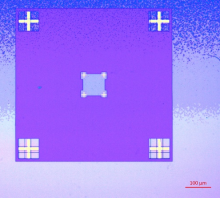
The activity concentrates on the sources of high quality material and its manipulation. Two large categories of materials are the focus here:
Regarding carbon nanotubes (CNTs) it is critical to control the chirality, diameter, placement and surface functionalization of the nanotubes used in various applications. Our aim so far has been to control surface functionalization and deposition methods in order to create well controlled CNT depositions on various substrates. Those “carpets” as they are called have been used to develop CNT based components such as transistors (CNTFETs) and other. The original material is until now aquired through external collaborations (Chalmers Univ., SHT) or commercial vendors.
Regarding layered materials (two dimensional materials) the majority of research was originally conducted using exfoliation. The technique was mastered in collaboration with a spin off company of the A.Geim / K.Novoselof group (Graphene industries Ltd). Since 2012 graphene grown on SiC by sublimation (Linkoping University) and CVD grown material (Commercial Graphenea Ltd) was used. Since January 2017 a dual CVD system able to grow graphene and Transition Metal DiChalcogenides (TMDCs) using solid precursors was commissioned. This provided large area material for electronics and other applications. Transfer of 2D materials from the growth substrate to any arbitrary surface has been developed based on a wet process. Finally, chemical liquid exfoliation is still used to provide large volume of nanoflake quality materials used in the 2D based senors

The concept of material with inherently low dimensionality as the core of nano-electronics has been around since the 80’s. Carbon nanotubes have been investigated since their structure is natively inert and they have a quantum wire structure that offer ballistic transport over large distances. With the invention of 2D materials this area has gained enormous attention. Now not only CNTs but also a large pool of monolayer nanomaterials are available for use and above all offer 1D as well as 2D structures with no dangling bonds. Graphene was the first one to exhibit experimentally mobilities in the tenths of thousands but other materials are also promising. The target of this activity is to establish the know how at the component level and harvest the unique properties of each nanomaterial to achieve a series of new electronic components such as transistors, diodes, antennae and other that operate at higher frequencies, consume less power and are more robust and / or smaller than their conventional counterparts. The microelectonrics group has initiated research in this field back in 2008 (first published record 2009) and has since then systematically studied 2D materials and CNTs at the component level. With the aid of several european projects (FP7 and H2020) this activity is currently at the forefront of research with several SotA components.

Two dimensional materials are a promising candidate for sensing applications for several reasons.
Regarding chemical sensors, the form factor of such materials offers a large interaction with the environment. Furthermore specifically graphene offer the particularly rich and well established chemistry of Carbon materials that provide a clear pathway to chemical selectivity. In this area we are the first (in collaboration with European partners) to develop a surface acoustic wave based sensor that can detect acetone, relative humidity and other chemicals that are of importance for food industry and other applications.
Regarding radiation sensors, the fact that graphene has zero bandgap could be considered a disadvantage for several applications (such as graphene FETs) but in this case it offers a unique characteristic: Graphene will absorb any radiation (ranging from THz to the visible). This characteristic has been used to develop to unique sensors, a ballistic transport sensor for GHz (published 2012) and a polariton based THz bolometer recently developed (published 2018). Finally work has begun on photodetecting devices based on TMDC material (both nanoflakes as well as CVD material. This activity is in early stages but complements the remaining spectral range of radiation sensor development.
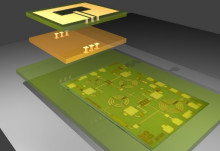
Building on the previous activities, the target is to agglomerate all components into a functional smart nano-system for GHz wireless applications. Circuit level design and integration is the main objective of this activity. Specifically, combining components coming from nanomaterials such as CNT and 2D on the same integrated system (monolithic integration) can provide the best of each technology. This approach also is particularly adapted to the logic of sequential integration, that is combining different materials / tecnhologies on a monolithic approach. In collaboration with THALES, France and a large consortium of partners, we have pursued this logic to create the first nano sized smart wireless transmission and reception integrated circuits based on CNT and Graphene. As the key technology partner in this effort, we have already developed a library of components and a process flow that enables all basic devices (transistors, inductors, capacitors, transmission lines) to be fabricated at the low GHz range based on graphene and CNT technology.
Heads
Technical Staff
Alumni
Infrastructure Equipment
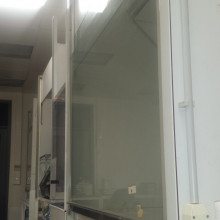
The lab was recently (2015) launched to cover the needs of the activity. The clean room ensures stable Temperature / Humididty environment and is separated in three zones:
Zone 1: General processing
The main target if this zone is to enable hands on access to students (starting from undergraduate) to perform hand on work using basic equipment. This zone is equped with a solvent wet bench, spin coating and hotplates, optical microscopy and profilometry.
Zone 2: RF Characterization
This zone hosts a series of Temperature / humidity sensitive equipment such as RF characterization, a custom Electrical Impedance spectroscopy setup and other characterization tools shown below)
Zone 3: Nanoparticles & 2D growth and manipulation
The last zone focuses on nanoparticle handling (2 nanoparticle tolerant wet benches/hoods with exhaust filtration), a custom made Langmuir Blodgett system, a series of sonicators, precision scales, inert atmosphere glove box, and ovens
In this zone the 2D dual CVD growth system is also placed (Graphenes and Transition metal dichalcogenides)
For information or to request access to the lab please contact George Deligeorgis
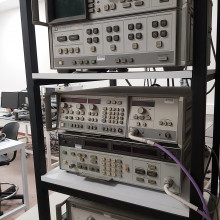
The system aims at characterization of on-wafer or other prototype RF systems.
It is based on the following units:
- HP8510c VNA
- custom made high voltage Bias-T (up to 200Volts)
- Keithley 2614B ( High voltage version )
- On-wafer probe station (2 RF probes, aditional DC probes available)
- Labview control using PC
For further information or to request access please contact George Deligeorgis
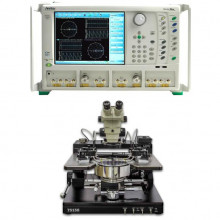
The system aims at characterization of active components on-wafer or other prototype RF systems.
It is based on the following units:
- Anritsu MS4644B VNA
- Power control option (Performs Compression point analysis)
- Noise figure (Performs Noise figure measurmeent with proper aditional amplifiers)
- Keithley 2604B ( 2 port biasing and current measurement )
- On-wafer probe station (2 RF probes, aditional DC probes available)
- Labview control using PC
For further information or to request access please contact George Deligeorgis
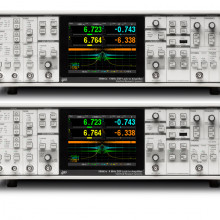
The system was developed in house and is built around a dual lockin setup.
It is capable of measuring:
- Frequency range: 1mHZ - 4 MHz
- Stimuli Voltage range: nVolts - Volts
- Response voltage range: nVolts - Volts
- Current response range: pA - mA
The system can also operate in conjuction with the RF_VNA to cover a range of 9 orders of magnitude in frequency
Measurement can be:
- On wafer (probe station)
- Liquid cell (custom built)
- Temperature cell (under development)
All experiment and data are controlled via dedicated LabView through PC
For further information or to request access / measurements please contact George Deligeorgis
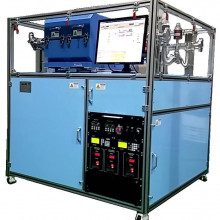
This is a dual chamber Graphene / Transtition metal dichalcogenide CVD system developed by PlanarTECH the system is a planarGROW-2S
The graphene chamber has:
- Quartz 2" growth tube
- SIngle growth zone up to 1100 C
- Heated precursor chamber
- Input gasses are:
- Hydrogen / Methance / Argon
- Automatic
- pressure
- flow
- pump control
- Full recipee mode
The TMD chamber has:
- Quartz 2" growth tube
- Double growth zone each up to 1100 C
- Input gasses are:
- Hydrogen / Argon
- Automatic
- pressure
- flow
- pump control
- Full recipee mode
For more information or to request access / samples please contact George Deligeorgis
We are proud to work with the Libre Space foundation in multiple space related projects:
- We provided consulting in the SatNOGS COMMS project designing a communication platform for CubeSATs and nanosatellites.
- We are also excited to be part of the SidLOC ESA project providing RF design services.
The focus of this activity is developing radio frequency (RF) and mm-wave analogue components and circuits incorporating sensors aiming at increased complexity, higher power (using wide bandgap semiconductors) and exploring future transparent and flexible electronics for high frequency. Application are mainly in near future wireless smart systems, radars and other more than Moore approaches. Within this activity smart sensors for biomarkers are also explored.
Research Topics

Electromagnetism has a profound effect on our lives since applications such as wireless and satellite communications, space, airborne or ground active array radars, cable TV, and smart automotive infrastructure all depend on it. All of them are in continuous need of components with improved performance at higher power & frequency, smaller footprint & volume, with increased functionalities and at a lower cost and enhanced reliability. Novel solutions need to be sought to enable the next-generation of products with the efforts focusing on RF front ends (transceivers TRX modules) which are the key electromagnetic component that allows emission and reception of electromagnetic waves. Currently such innovative technologies are GaN based electronic components (high power capacity, low noise, chemically and thermally robust) and RF Microelectromechanical switches (MEMS) (lower insertion loss, higher isolation, greater power handling).
MRG in collaboration with Thales SA (France) has been developing technologies for the monolithic integration of GaN based Monolithic Microwave Integrated Circuits (MMICs) with RF MEMS focusing more on what is termed “coplanar approach”. MRG has already developed GaN based coplanar high power transistors operating in the X-band exhibit performances at par with commercially available “microstrip” ones such as the UMS GH25 transistor. MRG is currently attempting to set up a pilot line for the production of such RF front end modules.
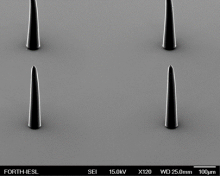
Starting around 1970, Surface Acoustic Wave (SAW) devices were developed for pulse compression radars, oscillators, and band-pass filters for domestic TV and professional radio applications and recently for mobile or satellite communication systems. The shift of the resonance frequency of a SAW resonator, as effect of change of various physical parameters (temperature, pressure, mass loading, etc.) make these devices very useful in sensing applications. The traditional materials (quartz, langasite, langatate) used in SAW resonators manufacturing have excellent piezoelectric properties but they have also the disadvantage of their limited operating frequency, which remains normally below 2 GHz. Lately, the amount of data transmission in wireless network systems is increasing and the demand for SAW devices operating at frequencies around 5 GHz becomes important. Also in sensor applications, the sensitivity increases with the resonance frequency, being proportional with the square of the resonance frequency for mass, humidity and gas sensors. According to the wave mode there can be waves of Rayleigh, Lamb or a combination of both category. Wide bandgap (WBG) materials like GaN and AlN have very good piezoelectric properties and significantly higher acoustic velocities and are increasingly used for acoustic devices.
For over a decade, MRG has been developing SAWs, Film bulk acoustic resonators (FBARs) mainly for temperature, pressure and humidity sensing, Lamb resonators for biosensing (e.g. protein detection) and UV photodetectors. Key parameters are the developed micromachining process for extremely thin GaN membranes (below 500nm) and the electron beam lithography protocols for extremely narrow and densely packed interdigitated transducers (IDTs) as thin as 100nm with 100nm period.
This activity has resulted in more than 15 publications in established journals with citations in the range of 600 and in numerous conference presentations.
Acoustic sensors: For over a decade, MRG has been developing SAWs, Film bulk acoustic resonators (FBARs) mainly for temperature, pressure and humidity sensing, Lamb resonators for biosensing (e.g. protein detection) and UV photodetectors. Key parameters are the developed micromachining process for extremely thin GaN membranes (below 500nm) and the electron beam lithography protocols for extremely narrow and densely packed interdigitated transducers (IDTs) as thin as 100nm with 100nm period.
EEG sensors: Within the past 5 years, MRG has developed a dry microneedles based Electroencephalogram (EEG) electrode with simple fabrication involving just a single lithography step without the use of “sacrificial” substrates. The resulting process is therefore simpler and of lower cost.
Gait sensors: MRG as part of a Greek collaborative effort, is working towards the design and manufacture of a smart, wearable insole (Smart Insole) with built-in pressure measurement sensors, other micro-electronic sensing elements and communication devices to tackle the challenge of efficient gait monitoring in real life. This wearable insole is based on unique layer that consists of a polymeric material with embedded piezoelectric flakes, an inertial measurement unit including a triaxial accelerometer, gyroscope and magnetometer to capture the gait characteristics in motion.
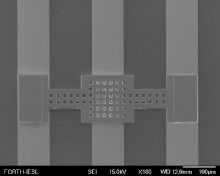
Future RF systems are in continuous need of components with improved performance at higher power & frequency, smaller footprint & volume, with increased functionalities and at a lower cost and enhanced reliability. Aggressive miniaturization is the key requirement for future RF Transceiver (TRX) systems. In order to achieve, there is a need to transform current TRX 2D architecture into 3D heterogeneously or sequentially integrated one.
MRG conducts research in III-nitride based MMIC, III-nitride based sensors and RF MEMS and has already demonstrated the monolithic integration of MMICs with RF MEMS. A major advantage of III-nitride based acoustic sensors is the possibility of monolithic integration with other active and passive circuit elements, enhancing the future development of smart microsystem technological platforms on this material. In particular MRG is working on the idea of “all-in-Gallium Nitride” solution involving MMICs, RF MEMS, multimodal sensors supported by disruptive nanotechnologies such as 1D &2D materials, which will deliver a single transceiver component which will radically transform the current 2D TRX architecture into a 3D System in Package (SiP).
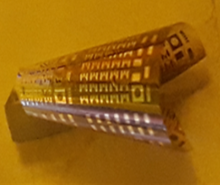
Transparent and Flexible electronics are part of the Key Enabling Technologies of Nanotechnology, Advanced Materials, Photonics and Micro-Nanoelectronics. Flexible and transparent electronic devices and systems can find applications in the high growth market sectors of healthcare, smart packaging for food and pharmaceutical products security, human-machine interfacing, sensor networks, automotive electronics, the Internet of Things, flexible displays, wearable gadgets and other emerging chip markets.
The activity on flexible and transparent electronics within MRG employs low temperature PVD deposition techniques like rf sputtering and rf magnetron sputtering for fabricating n-type and p-type nanostructured oxides, nitrides and oxynitrides like ITO-N, ZnO-N-Al, Ir, NiO-Al, TaO-N, ZnSnO, CuO, etc, with controllable properties and long term stability, on flexible substrates (PET, glass, etc). By making use of innovative and low-cost fabrication-approach devices, TTFTs, photo-transistors, transparent diodes and transparent PVs are developed.
Heads
Technical Staff
Research Associates
Alumni
Infrastructure Equipment
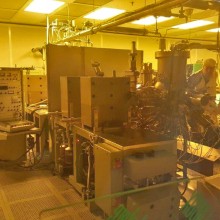
Molecular Beam epitaxy system by VG 80H with automated control.
- Capable of handling up to 3" substrates
- RHEED 15KeV system
- Mass spectrometer 1 - 300 amu
- K-cells for Galium (2), Aluminum (2), Arsenide, Indium, Silicon and Berilium
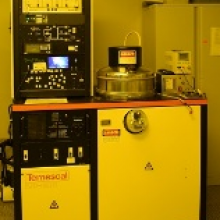
UHV e-beam evaporator with an 8 target turret and in situ ion beam cleaning system.
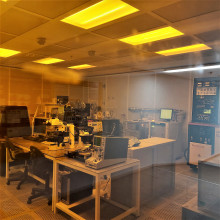
Two thermal evaporators (Home-made)
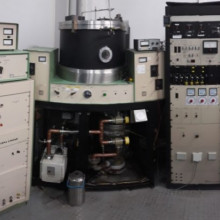
RF diode and RF magnetron sputtering system with 3 electrodes.
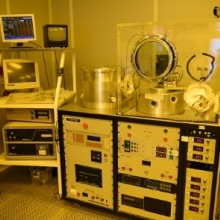
Reactive Ion Etching system (Vacutec 1500) with in situ laser interferometry and optical emission spectroscopy end-point detection techniques (Jobin Yvon Sofie)
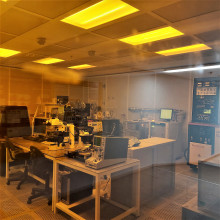
Inductively Coupled Plasma Etching system (Oxford Plasma Pro 100 Cobra)
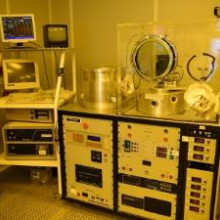
Plasma enhcanved CVD system (Plasmatherm Vision 310 PECVD) with stress control of Si3N4 achieved by using mixed-frequency deposition or low-damage He dilution.
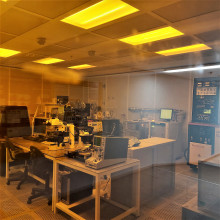
Atomic layer deposition (Picosun R-200 Advanced) with sources for Aluminum oxide and Hafnium oxide deposition capability) + Ozonator (InUSA AC Series Ozone Generator)
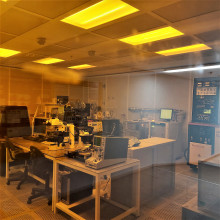
Programmable 3-stage tube furnace (Carbolite)
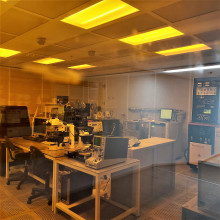
Two programmable hot plates with vacuum (UniTemp GmbH VHP-210-160)
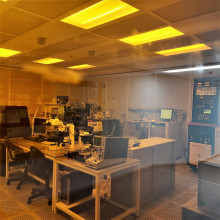
Two programmable spinners up to 6” (Suss MicroTec LabSpin 6BM)
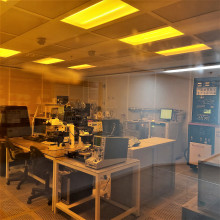
Electron beam writer attachment (Raith Elphy Quantum) for the field emission SEM (Jeol 7000F)
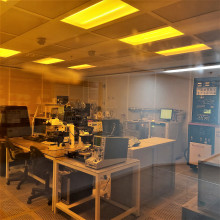
Programmable horizontal tube (3”) furnaces up to 1200°C (ELITE Thermal Systems Limited TMH12/75/750)
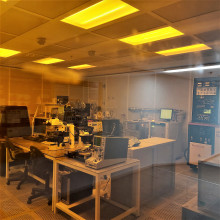
Semiconductor Characterisation System (Keithley K4200):
- Two SMUs (max 0.1A, max 210V, 2W)
- High power SMU (1A, 210V, 20 W)
- DC and pulsed measurements ( 500 ns minimum pulse width)
This activity focuses on energy handling and recovery. The focus is on functional materials for smart glasses and zero energy buildings, next generation, high efficiency III-N photovoltaics and nanowire solar cells, as well as high power, high voltage (KVolt) SiC based electronics for grid power management.
Research Topics
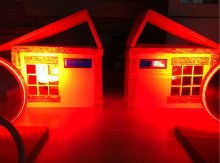
With an increased awareness on environmental issues and to compete with COP21 Paris agreement, there is a challenge for physicists, chemists and engineers to develop new products, processes and services that can achieve critical societal, economic and environmental objectives. Green Technologies and Green Engineering are the answers to that challenge and these are the issues this activity is trying to tackle.
It is known that for minimizing energy in buildings (which are responsible for 35-40% of total final energy consumption) and using eco-sustainable resources, the design and development of high performance self-powered user-controlled smart window systems based on functional strongly correlated materials, oxides and solid-state electrolytes can enhance solar and thermal management of buildings, transportation means, etc. The development of such functional materials on flexible substrates (PET, glass, etc) can subsequently be mounted on a carrier glass with its proprietary bonding solution and provide energy saving in old buildings (retrofits), etc.
The activity on functional materials for smart and energy autonomous glasses & windows within MRG employs low temperature PVD deposition techniques like rf sputtering and rf magnetron sputtering for fabricating bio-inspired thermochromic coatings (VO2-based), energy autonomous solid-state electrochromic devices (WO- and NiO-based) and transparent photovoltaics and thermoelectric generators.

Power transistors based on wide band gap semiconductors are subject of intensive research the last decade. The high current and high voltage capabilities of these devices, largely exceeding that of Si devices, represent a challenge on various aspects related to the device fabrication, characterization and packaging. JFETs have the lowest overall losses of switching devices and their fabrication process is quite straight forward. The main drawback with VJFETs is that they are usually normally-on (depletion mode), which is considered unsafe in power applications. Moreover, JFETs are very robust devices with a channel not seriously affected from surface effects. This was the reason for developing SiC JFETs at FORTH.
The appropriate JFET geometry is significant: The usual 4H-SiC JFETs are either purely vertical (VJFETs with Static Induction Transistors-SITs operation) or Semi-lateral (SLJFET). Optimum SLJFET fabrication requires two-step implantation and re-epitaxial growth after material etching on specific locations. Trenched VJFET requires only one implantation step and the fewer lithography steps. The only difficulty is the tight control of the dimensions, which are of the order of 1-2 μm for both source pillars and gate pitch arising, thus, an issue of tight registry control. For the above reasons, the trenched and implanted TI-VJFET have been chosen.

The III-Nitride semiconductors and in particularly InGaN alloys have a tremendous potential for high efficiency/lower cost next generation earth and space photovoltaics, due to their direct bandgap extended range, polarization fields and high radiation and chemical resistance. However, despite international efforts for more than 10 years this potential has not been realized. Based on MRG’s unique know how for state-of-the- art epitaxial InGaN materials we aim to address bottlenecks and substantiate their photovoltaic potential. With suitable for photovoltaic applications characteristics, state-of-the-art InGaN thin films have been realized in the entire composition range and their optoelectronic properties were accurately evaluated. Particular emphasis was given to avoid compositional fluctuations that act as potential minima to trap photo-generated carriers. The traditional approaches to III-N p-i-n solar cells have been examined and it was revealed the important role of polarization field in opposing efficient carrier collection. Therefore new design approaches based doping-polarization engineering has been implemented and extended device simulation, based on experimental material parameters, were employed to optimize parameters for maximum conversion efficiency in single n-InGaN/p-GaN heterojunctions and tandem n-InGaN/n-p Si junctions. Novel device processing approaches have been investigate to address specific bottlenecks problems in device realization.
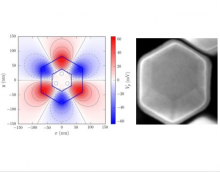
In the quest for next generation photovoltaic technology, nanowire solar cells attract wide interest for two reasons. First, the enhanced light absorption of nanowire arrays, based on their anti-reflecting properties, light trapping and resonant waveguiding effects, allows for an order of magnitude reduction in the amount of materials, needed for an efficient solar cell. Second, due to their large surface/volume ratio, nanowires exhibit relaxed lattice-mismatch requirements allowing for high quality nanowire growth on less costly substrates (e.g. GaAs nanowires on Si). Recently, a conversion efficiency of 15.3% has been demonstrated using GaAs nanowires, underlining their potential to compete with other solar cell technologies. A critical parameter in fabricating a nanowire solar cell is the uniformity of the nanowire array. This issue is typically addressed by pre-patterning the substrate in order to trigger simultaneous nucleation of the nanowires. This pre-patterning step, however, adds to the complexity and cost of fabrication of the nanowire arrays. In this project, we have devised a new method producing highly uniform GaAs nanowire arrays on unpatterned Si substrates. The method consists of a controlled chemical oxidation process to replace the native oxide on Si(111) substrate with a reproducible chemical oxide.
Heads
Technical Staff
Alumni
To develop multi-dimensional models pertaining to Magnetic Fusion, for the Eupoean Fusion Progrramme. (i) 3-D Pellet Modelling, & (ii) Modelling of alphas from thermonuclear reactions using fluid approximations.
The two tasks will contribute to the fuleling and to the physics basis, of iter and demo. The tasks are part of the work plan for the implementation of the FUSION ROADMAP IN 2014-2018.
RESEARCH QUALITY INDICATORS – HIGHLIGHTS- ACHIEVEMENTS
PELLET ABLATION MODEL (1.5-D) HAS BEEN DEVELOPED [CONTB. PLASMA PHYS. 48, 2008, PLASMA PHYS. CONT. FUSION, 50, 2008] BURNING PLASMA MODEL(1-D) HAS BEEN DEVELOPED [PHYSICS LETTERS A, 377, 2013] ORGANIZED THE 2008 EUROPEAN PLASMA PHYSICS CONFERENCE
COLLABORATIONS
- IPP-GARCHING, GERMANY.
- TECHNICAL UNIVERSITY OF CRETE
- UNIVERSITY OF IOANNINA
- UNIVERSITY OF NSW, SYDNEY AUSTRALIA
FUNDING
The project is funded by EURATOM, via the Greek Association for the Period 2005-2012 with 322.845 EURO.
SOCIO-ECONOMIC IMPACT (OF FUSION RESEARCH IN GENERAL)
EURATOM has the objective to place electrical grid from a FUSION Reactor by 2050. If this is achieved the impact will be of great dimensions. Present time impact is the international collaboration for Iter, which is being built in France.
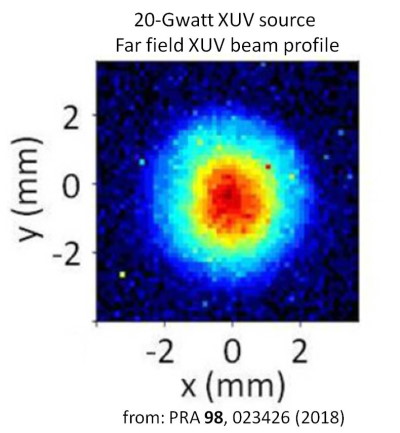 The long-standing scientific quest of real-time tracing electronic motion and dynamics in all states of matter has been remarkably benefited by the development of intense pulsed laser sources with a temporal resolution in the attosecond (1 attosecond (asec) = 10^-18 sec) time scale. In the last 15 years we have systematically developed the means for the generation of high photon flux extreme ultraviolet (XUV) pulses with 1fs to sub-fs pulse duration, making use of the process of higher order harmonic generation (HOHG). Utilizing multi-cycle laser pulses delivered by high peak Ti:S laser systems, in combination with Polarization Gating techniques [1], XUV pulse intensities up to 10^14 W/cm2 have been reached in the spectral region 10-24 eV. These pulses have been exploited in I) the temporal characterization of attosecond pulses [2-4]; II) the first proof of principle XUV-pump-XUV-probe experiments for the study of 1fs scale electron dynamics in atoms/molecules [5, 6], and III) quantitative studies of linear and non-linear ionization processes in XUV regime [7,8].
The long-standing scientific quest of real-time tracing electronic motion and dynamics in all states of matter has been remarkably benefited by the development of intense pulsed laser sources with a temporal resolution in the attosecond (1 attosecond (asec) = 10^-18 sec) time scale. In the last 15 years we have systematically developed the means for the generation of high photon flux extreme ultraviolet (XUV) pulses with 1fs to sub-fs pulse duration, making use of the process of higher order harmonic generation (HOHG). Utilizing multi-cycle laser pulses delivered by high peak Ti:S laser systems, in combination with Polarization Gating techniques [1], XUV pulse intensities up to 10^14 W/cm2 have been reached in the spectral region 10-24 eV. These pulses have been exploited in I) the temporal characterization of attosecond pulses [2-4]; II) the first proof of principle XUV-pump-XUV-probe experiments for the study of 1fs scale electron dynamics in atoms/molecules [5, 6], and III) quantitative studies of linear and non-linear ionization processes in XUV regime [7,8].
The latest technological advance towards an XUV high photon flux attosecond pulsed source is the newly constructed ≈ 18 m long (HHG) 20 GWatt XUV beam line [9]. The beam line beam line provides the highest ever XUV pulse energy (≈ 230 µJ per pulse) in the spectral region 20-30eV. The corresponding photon flux of 0.6 X 10^14 photons/pulse is competitive with FEL photon fluxes in this spectral region. Using these pulses a focused intensity of ~7 X 10^15 W/cm^2 has been achieved (a value that by using high reflectivity XUV optics can be increased to 10^17 W/cm^2) and multiply charged Argon atoms (Ar^4+) have been produced by multi-XUV-photon ionization processes.
References:
[1] P. Tzallas et al. Nature Physics 3, 846 (2007)
[2] P. Tzallas et al. Nature 426, 267 (2003)
[3] L. A. A. Nikolopoulos Phys. Rev. Lett.. 94, 113905 (2005)
[4] Y. Nomura et al. Nature Physics 5, 124 - 128 (2009)
[5] P. Tzallas et al. Nature Physics 7, 781 (2011)
[6] P. A. Carpeggiani, et al. Phys. Rev. A 89, 023420 (2014)
[7] N. Tsatrafyllis, et al., Sci. Rep. 6(1), 21556 (2016).
[8] P. Tzallas, et al., J. Opt. 20(2), 024018 (2018).
[9] A. Nayak et al., Phys. Rev. A 98, 023426 (2018)
The treatment of patients with bone defects can pose significant challenges and often require surgical intervention. Several biological requirements must be met for a successful tissue-engineered device for bone repair. It should be biocompatible, osteoconductive, osteoinductive, osteogenic and osteointegrative. In addition to biological factors, an ideal bone tissue scaffold should satisfy several physical requirements. Therefore, there is a major clinical need for versatile, slowly degrading, biomaterial systems for bone repair that mimic the architecture, the mechanical and bio-stimulating functions of native bone. The main goal of the OSTEOBIOMIMESIS project was to address these challenges by investigating the cytocompatibility of synthetic biodegradable composite biomaterials. By controlling the mechanical properties of these materials, we used them as scaffolds for bone tissue regeneration. Specifically, we successfully (i) designed and synthesized copolymeric composites based on chitosan and ε-polycaprolactone with various chemical compositions; (ii) systematically explored the changes in the copolymeric composites’ mechanical and nanomechanical properties in the hydrated state; and (iii) assessed the scaffolds’ osteogenic potential in vitro in pre-osteoblasts and human bone marrow (BM) mesenchymal stem cells (MSCs). Our hypothesis was that changes in the biomaterials density correspondingly lead to changes in scaffolds’ mechanical properties and cellular condensation, thus influencing the cellular microenvironment that favor osteogenesis. By being able to control mechanical performance through chemical composition, we were able to improve the interactions between the scaffolds and the cells in order to achieve the highest differentiation potential of hBM-MSCs.



